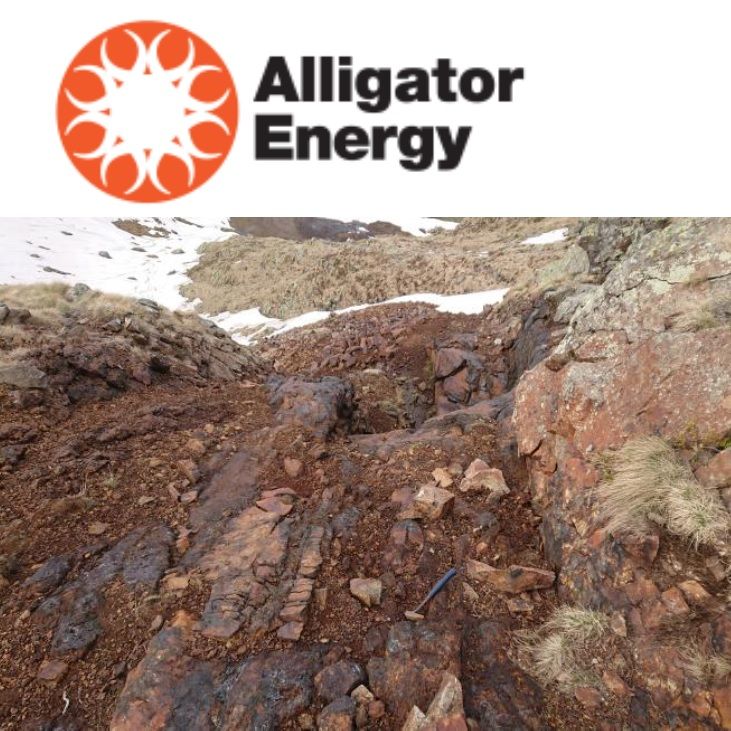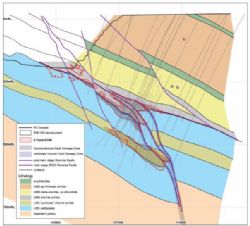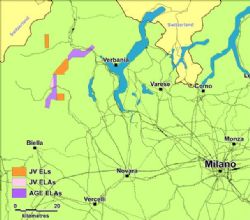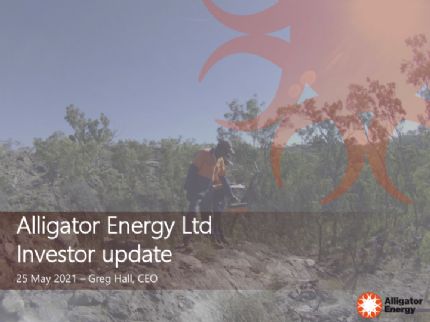
Market Update - Strategic Review and Next Steps
Brisbane, April 4, 2019 AEST (ABN Newswire) - Alligator Energy Ltd ( ASX:AGE) provides the Company's market update.
ASX:AGE) provides the Company's market update.
Highlights - Alligator Rivers Uranium Province (ARUP)
- Alligator (AGE) broadens its understanding of the regional geological setting, directly effecting the targeting strategy moving forward.
- Advanced geophysical data re-processing is being trialled to 3D model the sub-Kombolgie structural and lithological settings.
- New Structural and Regional geological interpretations generated in conjunction with a leading ARUP and global uranium exploration geologist, and an experienced ARUP structural expert.
- Key outcomes:
o Historic and AGE derived data was used in a re-interpretation of the lithology below the Kombolgie sandstone cover (sub-Kombolgie).
o In particular, this included modelling the Lower Cahill-Archean Gneiss contact - deemed the favourable setting for potential large-scale mineralisation.
o AGE has identified as a critical control the older 'structural settings' which are evident in the major uranium deposits in west Arnhem.
o Updated uranium control models of the Ranger, Ranger 3 Deeps and Jabiluka deposits were incorporated to generate new targets.
o Key zones of the highly prospective Lower Cahill-Archean gneiss contact within TCC project tenements were interpreted on a regional scale extending into the Narbarlek North applications (adjacent to existing high grade uranium intersection) and south through Beatrice project tenements.
- A review of the effectiveness of exploration tools used by Alligator, its peers and historic explorers was incorporated into the review.
- Alligator's TCC projects, along with the Beatrice project and the Narbarlek North application area, were reaffirmed as being of significant interest as targets.
- A one and three year plan has been formulated to allow systematic considered exploration - detail set out below.
- New application EL32075 (16.26Km2) confirmed adjacent to existing Narbarlek North applications further improves AGE's ARUP holdings.
- Identification of, and early discussions with, potential strategic partners has commenced to allow this sustained longer term approach.
AGE's CEO Greg Hall commented today: "The work completed by the Alligator technical team is of outstanding quality and re-enforces the high prospectivity for a globally significant uranium deposit to be hosted within Alligator's project areas. The re-interpretation of the historically uranium fertile Lower Cahill-Archean gneiss contact , which underlies the Ranger and Jabiluka deposits, on AGE's tenements is extremely important.
Combined with AGE's historic and current work on older structural zones, and U targeting techniques, we believe is the right approach for discovering large scale uranium deposits. Furthermore we believe the need for a strategic measured approach to exploration is of paramount importance and hence our 1 and 3 year initiative to achieve success".
Highlights - Piedmont Nickel Cobalt
- Alligator has now received a full project review from a world leading Nickel expert with experience in these style of nickel deposits.
- Key observations regarding the Piedmont Ni Co Cu region from the review report include:
o Unusually large number of Ni-Cu-Co sulphide occurrences directly related to intrusions which are similar to other known Ni bearing regions.
o Very good nickel tenor within the sulphides, with pentlandite being the main Ni bearing mineral.
o Combined with low concentrations of Ni in pyrrhotite indicate amenability to cost effective mineral processing with low Ni losses.
o The relationship of geophysical response (magnetics and VTEM) to geology and mineral occurrences, indicates that mineralogy of identified magmatic disseminated to semi-massive sulphide assemblages should respond to further modern geophysics.
- Proposed next steps to include shallow drilling of potential continuation of known massive sulphides and ground based EM to refine deeper drilling locations.
- Drill permit applications progressing with final granting anticipated by mid-year.
- Technical documentation is being prepared, and discussions with potential strategic partners and investors will commence shortly.
AGE's CEO Greg Hall commented today: "It is rare that an opportunity presents itself to have a first mover opportunity in an historic mining region which has had little or no modern exploration. The project has the potential and opportunity to be a globally significant provider for battery metals to the European Markets. The external review has provided the Board with the confidence to aggressively advance this opportunity, and highlights the great work completed by the AGE team in pursuing this project, and the Technical team for the significant progress made in just 3 months field time. We look forward to seeing some rigs turning!"
Corporate
The Company is delighted to announce that the employment contract with Greg Hall as CEO has been extended by a further twelve months. See further detail below.
Detailed findings by Project Area
Alligator Rivers Uranium Province
Strategic review - approach and key findings
Alligator is making significant progress in understanding the regional geological framework, directly effecting targeting strategy moving forward.
The Company is exploring West Arnhem for genuinely significant and economically viable uranium deposits within the ARUP. With this goal, most of AGE's work has focussed on the mineralisation systems that form the known occurrences of mineralisation >100mlb U3O8 rather than smaller <30mlb "Structural targets". However, if found, a combination of multiple structural targets of smaller size could be economically viable and would be pursued.
AGE compiled all historic and AGE derived data in preparation for a two-day workshop completed between AGE staff and two world two leading experts in uranium exploration geology and structural mineralisation controls within the ARUP. The key aims were to integrate the historic and recent work completed by all explorers in West Arnhem into the forward exploration strategy for AGE. This data included but was not exclusive to the AGE drilling at TCC4, the exploration and discovery of the Angularli deposit, and historic data from the region. A 1 year and 3 year recommended plan was then developed.
A systematic review of all available exploration data and uranium occurrences was completed including in particular re-assessment of publicly available data and models of Ranger, Ranger 3 Deeps and Jabiluka deposits. The Ranger 3 Deeps mineralisation setting and model is shown in Figure 1(see link below) - indicating the structural settings within this.
The direct results of this initial workshop included the generation of a regional sub-Kombolgie lithological re-interpretation in the region of our tenements, with an emphasis on highlighting the lower Cahill-Archean gneiss contact which is deemed as the favourable setting for potential mineralisation. Furthermore, the critical control that 'structure' has on the major known uranium deposits in West Arnhem was studied.
Whilst a series of academic arguments exist surrounding the dynamics and formation of these deposits, the critical components are:
- Presence of old deep-seated mineralised basement tapping structures is essential.
- Shallow cross-cutting reverse fault systems are Key controls at Ranger and Jabiluka and as a result are priority identification targets.
- The Lower Cahill hosts the currently known big deposits because of variations in lithology contrast allowing a brittle/ductile fracturing and change in redox conditions.
- Proximity to a basement Archean source lithology is deemed more important than proximity to the unconformity.
The AGE team and consultants spent considerable time re-interpreting the Lower Cahill - Archean Gneiss contact zone. This review included evaluating all AGE data (surface and drilling), other publicly available mapping and drilling data, and NT Govt surface geological mapping. While further investigative work to finalise this is required, the re-interpreted contact zone highlights that the eastern part of Alligators project areas remain very prospective, including the TCC projects area, and the Narbarlek North project area which is currently under application (refer Figure 2 in link below). The Narbarlek North application area is adjacent to one of the highest grade intersections in the ARUP, and while still masked by the overlying Kombolgie sandstone, the thickness of sandstone is reduce compared to the TCC projects region.
A review of the tools used by Alligator, its peers and historic explorers was incorporated into the review, with the effectiveness of each tool assessed for exploration for the mineralisation model being targeted within the environment which Alligator are exploring. The review included the revisit of the AGE exploration data collected, with an emphasis on the on the proprietary techniques developed by AGE. The isotope exploration analysis remains an important tool to delineate prospective blocks on Kombolgie cover, whilst the SAM technique highlighted its effectiveness in close spaced target refinement tool by highlighting tighter structural features and areas of alteration.
The direct implications of the results of the 2018 drilling at TCC4 show that whilst no mineralisation was encountered from the first pass drilling, the broader area remains prospective. It is now suggested that the decay Pb isotope anomaly over TCC4 could be from a uranium zone(s) perhaps at depth under the Mintaka / South Horn region. This original mineralisation could have been substantially altered / remobilised by further events, and then even displaced (stoped out / pushed upwards) by the large dolerite intrusion present (Caramal being an example where dolerite stopes out mineralisation). The initial work that AGE has completed indicates that this zone is still prospective for uranium mineralisation at depth, possibly adjacent to, or being masked by the dolerite.
Deeper drilling would be required - initially for stratigraphic determination, then for mineralisation targeting. Alligator will continue to review the area, as the key stratigraphic and structural features are present with significant uranium in the system.
Proposed 1 and 3 Year ARUP Work Program
(a) 2019
As previously advised, Alligator seeks to attract an external strategic partner to sustain a 3 year exploration strategy for the West Arnhem uranium projects. The results from this workshop will directly feed into this approach to potential parties, however the year 1 plan has now commenced.
The immediate one year plan will now focus on precisely delineating the prospective geological contact of the Archean and Cahill, along with the identification and classification of all detectable basement structures.
Both of these aspects have commenced, with an external geophysical group being engaged to run initial trials on the advanced processing of the wealth of available geophysical data with the aim to establishing a three dimensional sub-Kombolgie structural map. Currently no method exists to classify the extensive structures observed in the ARUP, however understanding structural relationships, ages and kinematics will be a key aspect to the discovery of a major uranium occurrence. More information of the methods and techniques of this will be provided once initial testing is completed, and any further work which may include an R&D component is assessed.
The workshop produced a re-interpreted geological map for West Arnhem, with a particular focus on the key stratigraphic settings of the other major uranium occurrences within the ARUP. The work will now entail refining and ground truthing where possible, the geological interpretation to delineate the prospective Archean - Cahill contact areas. This will include field mapping and locating and re logging any relevant regional drill holes.
A combination of these results will highlight any favourable stratigraphic setting where ~1750ma age reverse structures are likely to be present. Initial surface coverage of decay isotope sampling should be completed as a first pass assessment of any area deemed prospective.
As part of the review, the Nabarlek North project application area was highlighted as a high priority for further work; consequently Alligator will continue to pursue the application process with the relevant Stakeholders. Depending on this outcome, and if time permits, a geophysical data acquisition program will be planned, and possibly an initial drilling program targeting stratigraphic knowledge and mineralisation potential may be undertaken.
(b) 2020
The outcome of year one will have fully delineated the most prospective portions of the Alligator tenements. This may result in the rationalisation of the Alligator holdings, with relinquishment or further applications.
Further geophysical data acquisition may be required, on a broader level of Gravity and Magnetics over any areas that come to grant such as Nabarlek North project application or more localised SAM surveys over areas of high prospectivity where insufficient data coverage exist. Within year 2 a first phase of confirmatory stratigraphic drilling to test the lithological interpretation and any highlighted structures of potential will be completed (note that all drilling fulfils the dual purpose of stratigraphic testing and mineralisation search).
(c) 2021
The outcome of year three will have fully delineated the most prospective drill targets. An aggressive drilling program will be completed to satisfactorily test these targets.
Piedmont Project
Background
The Piedmont Project is located within an historic mining district with cobalt, nickel and copper mining taking place from the late 1800's to the end of WWII. Cobalt production grades of over 0.2% and nickel grades of over 2% were recorded as historic mine grade estimates within the Project area.
Alligator considers the Piedmont project prospective for Fe-Ni-Cu-Co massive sulphide deposits in gabbroic and mafic rocks. Previous work on the metallogenesis of the Hercynian orogeny of the Alps completed by Omenetto and Brigo in 1974 drew strong similarities with Sudbury type ores regarding the sulphide assemblages. Bigioggero et al. 1979 made a division of the deposits within the project area based on the metal association and geological settings, these categories were:
1) Mineralisation in layers of the cyclic units, proximal to metasediments
2) Mineralisation in layers of the main gabbro
3) Mineralisation in pipes
Alligator are exploring for all 3 mineralisation types. Virtually no modern exploration has been completed within the district, until a recent EM survey highlighted targets proximal to historic workings.
In November 2018, Alligator announced that they had completed the phase 1 ground work under the farm-in arrangement with Chris Reindler and Partners and had elected to move to phase 2.
Piedmont Project review and key findings
Last year AGE announced that it had identified a world leading nickel expert with experience in the style of nickel deposits in the region. This person was engaged to conduct a desktop review of the project area utilising:
- Alligator phase 1 field results
- Historic mining and exploration results
- Academic studies of the area
- Global comparisons of similar mineralisation styles
A full project review has now been received, highlighting the regional prospectivity and suggesting further work required. The key observations included:
- Unusually large number of Ni-Cu-Co sulphide occurrences directly related to intrusions which are similar to other known Ni bearing locations
- Very good nickel tenor within the sulphides, with pentlandite being the main nickel bearing mineral.
- Combined with low concentrations of Ni in pyrrhotite, this indicates amenability to cost effective mineral processing through nickel flotation with likely low Ni losses.
- The relationship of geophysical response (magnetics and VTEM) to geology and mineral occurrences, indicates that the mineralogy of identified magmatic disseminated to semi-massive sulphide assemblages should respond to further modern geophysics.
The observations highlighted the remarkable number of surface expressions of outcropping massive and semi massive Ni Co bearing mineralised locations. The number of these are noted as being exceptionally high, even when compared with a known mineralised nickel province such as Sudbury.
A focus was put upon the sulphide compositions (in 100% sulphide) to establish the viability of any potential discovery. The style, mineralogy and composition of sulphide mineralisation recorded in Piedmont is classified as likely amenable to cost effective processing and would produce a favourable concentrate final product.
A review of the geophysical data currently available was completed, with an encouraging relationship observed between the mapped and known geology and airborne EM data. Forward modelling was conducted to identify the feasibility of EM to detect massive sulphide mineralisation at depth and it was concluded that ground EM should clearly delineate any massive sulphide bodies of significance.
Proposed Piedmont Work Program
The outcomes of this review and further work completed by Alligator has highlighted the need for:
- Ground based EM over the Alpe Laghetto, Valmaggia and Sella Bassa prospects.
- Geological mapping on a broader (ultimately district) scale.
- Initial drilling at the Alpe Laghetto prospect to test the immediate continuity of the mineralisation and establish true geometries.
- Deeper drilling should be utilised once the ground EM results are analysed.
Alligator has noted and experienced first-hand the interest being shown by investors into potential sources of certain digital / battery minerals within non-controversial / stable regions of the globe. The historical Ni Co Cu mining region of Piedmont certainly fits this bill. Technical documentation is now being prepared for engagement and discussions with potential strategic partners and investors.
Corporate
CEO Contract
The Board is pleased to confirm that it has agreed with the CEO, Greg Hall, to extend his contract for a further 12 months effective 1 April 2019.
Paul Dickson, Chairman, said 'The Board would like to thank Greg for his enthusiastic and dedicated leadership of the Alligator team over the last twelve months. Greg is critical to driving the current project review process and we are delighted that we have been able to retain his executive involvement'.
Greg has agreed with the Board that his immediate key priorities will be as follows:
- Develop detailed technical documentation and presentations from the project reviews;
- Initiate additional evaluation work as identified in the Year 1 ARUP program;
- Continue early discussions with potential strategic partners, and identify further interest and proposals for involvement in the ARUP projects;
- Develop documentation, identify potential partners for the Piedmont Ni Co Cu project, and initiate discussions and proposals; and
- Complete drilling permitting process and approvals for Piedmont.
Details of the extension of Greg's employment contract are set out in Appendix 1(see link below).
To view figures, please visit:
http://abnnewswire.net/lnk/D4W7J15H
About Alligator Energy Ltd
 Alligator Energy Ltd (ASX:AGE) is an Australian, ASX-listed, exploration company focused on uranium and energy related minerals, principally cobalt-nickel.
Alligator Energy Ltd (ASX:AGE) is an Australian, ASX-listed, exploration company focused on uranium and energy related minerals, principally cobalt-nickel.
Alligator's Directors have significant experience in the exploration, development and operations of both uranium and nickel projects (both laterites and sulphides).
| ||
|










